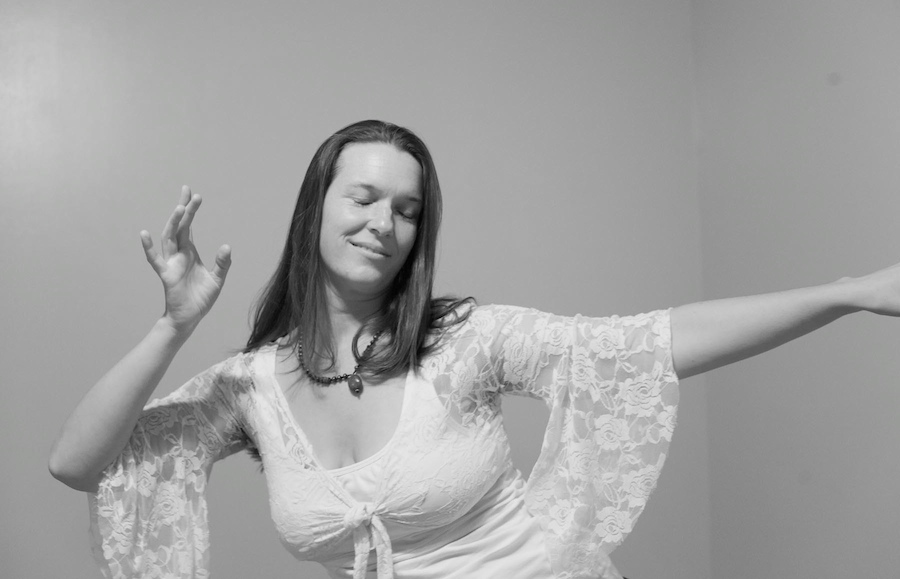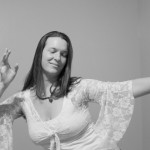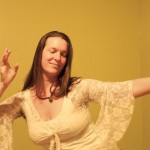Photo by Emily Nichols
A woman giving birth lies down on a hospital bed, surrounded by medical professionals clad in scrubs and latex. There are breathing exercises; perhaps pain medicine is administered. After some huffing and puffing from the mother-to-be, the doctor presents the exhausted but joyful woman with her new, blanket-wrapped infant. That’s the contemporary Hollywood version, anyway — the image of birth that we get from our mothers and movies.
Michelle Dionne, who teaches birth dancing and belly dancing classes in Asheville and the surrounding area, says that giving birth doesn’t have to be this way. In classes and workshops, Dionne encourages women to give birth standing up and teaches core-based movements derived from ancient belly-dancing techniques. The goal is to help ease the pain, quicken labor and “keep [women] in their bodies, keep them focused where the action is.”
Too weird? The image may not be what we’re used to, but Dionne — who danced through both her pregnancies and births — says that from a historical perspective, the lying-down-in-a-hospital-bed approach is the real oddity. “That was something that started just a few hundred years ago. [Before that], women were always on their feet,” says Dionne. “You have gravity on your side. And it’s much more comfortable to be up and moving.”
According to Dionne, birth dancing, which is essentially a style of belly dancing while pregnant, is an ancient technique. She says that belly dancing, which has since morphed into a form of entertainment in mainstream culture, was originally created for birth and sacred ceremonies.
Furthermore, birth dancing can be useful during “all stages of the birth journey,” including conception, pregnancy, labor and recovery. So while women who take birth-dancing classes might choose to give birth in a more traditional fashion, dancing before and during pregnancy will still have benefits. She says that belly dancing strengthens the core muscles that are “going to be expanding to carry the baby and are also the muscles that are going to be used to push out the baby. So becoming aware of those muscles and getting them strong is going to help greatly [in labor].”
And while core strength and body awareness are big parts of why a woman might choose to take birth-dancing classes, Dionne says the benefits go beyond the physiological realm and into the spiritual. Participants agree. “It feels like the ancient way we women used to commune together when we were pregnant for the health of our bodies and the preparation for labor,” says Laura Torres, whose home birth lasted three hours and incorporated the small movements she had learned from Dionne’s classes. “It feels really intuitive, and it helped me tremendously to be more present in my body and to feel my pelvis and feel the baby coming down the birth canal.”
Fostering a connection between the mind and body is one of the central goals of birth dancing. “Birth is an altered state,” says Dionne. “So dancing helps you be in an altered state but also in your body. Instead of trying to escape pain, or all of the coping mechanisms that we could go into [during birth], the dance helps a woman to go deeply inside her body, and being deeply inside her body is where she can transcend.”
Another important aspect of the dance is connecting — socially and spiritually — with other women. Torres says she “really appreciated meeting other moms and dancing with them. Just that glimpse sometimes out of the corner of my eye of all of us doing it together. It felt very bonding and beautiful and healthy. I could imagine us all in some forest glen 1,000 years ago just doing that naturally.”
While socializing and dancing with other pregnant women is a big part of the dance, there is also an opportunity to spiritually connect with women everywhere — past and present, says Dionne. The dance is a way to heal and connect with the feminine spirit, she says. “Doing these ancient movements makes you feel connected to the lineage of women,” Dionne explains. “I danced both of my babies into the world and could really feel ancestors and just all the women who gave birth coming through the movements.”
Mary Morgaine, who didn’t dance during her birth but participated in a weekly group class, says that the experience is “more than just dancing” and that the instruction allowed her to let go of a lot of the fear she had around giving birth. Dionne “really weaved in the sacred and feminine and what a magical process [giving birth] is,” says Morgaine. “Being able to give birth and go through labor … it’s not necessarily something that has to be so painful. Oftentimes our fear around it is what makes it so painful.”
“I want people to be aware of how ancient it is,” says Dionne. “It’s probably the first preparation for childbirth technique that ever was. It sounds so strange — I know it sounded strange when I first heard about it — but having done it twice, it’s the most natural thing in the world to bring your baby in this way. And I think it’s really wonderful for the baby too. When you dance throughout your pregnancy with your baby, they learn those movements with you. So during labor, I think it’s really calming for them.”
Learn more about Michelle Dionne and her dance classes at yellowsunfarm.blogspot.com. Contact Dionne directly at 664-9564 or yellowsunfarm@hotmail.com.






Before you comment
The comments section is here to provide a platform for civil dialogue on the issues we face together as a local community. Xpress is committed to offering this platform for all voices, but when the tone of the discussion gets nasty or strays off topic, we believe many people choose not to participate. Xpress editors are determined to moderate comments to ensure a constructive interchange is maintained. All comments judged not to be in keeping with the spirit of civil discourse will be removed and repeat violators will be banned. See here for our terms of service. Thank you for being part of this effort to promote respectful discussion.